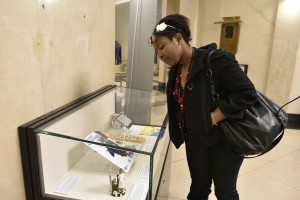Vaccination Exhibition
One of the most widely discussed forms of public health protection over the past seventy years has been vaccination. For many, immunisations against poliomyelitis and diphtheria are lauded as great triumphs of modern medicine. For a minority, they are seen as dangerous artificial interventions that do more harm than good. And while majority scientific and lay opinion has backed the United Kingdom’s vaccination programme across the post-war period, occasionally there have been medical scares over polio, whooping cough or MMR to sew the seeds of doubt among parents and doctors alike.
Over the summer of 2015, Placing the Public worked alongside external relations and the Libraries and Archive service at the London School of Hygiene and Tropical Medicine to create an exhibition of artefacts that shed light on some of these issues. Historical material sits alongside the valuable work currently being undertaken at the School to show that vaccination has a long history – and it isn’t going away any time soon.
 We would like to thank the Centre for History in Public Health and the Vaccine Centre at the School for their help in organising and promoting the exhibition. Special thanks also to Paul Fine and Brian Greenwood for their objects, including a 1970s jet injector and a hand-made stencil for advertising a reward for reporting smallpox cases; to Anton Camacho, who has adapted his modelling work on the Ebola outbreak; Alex Hailey of the British Library, who has given us access to documents from the British India Office; Claire Frankland and Victoria Cranna at the School’s Library and Archive for their help in liaising with the British Library, and providing access to the School’s extensive rare books collection; Joe Haynes at the Vaccine Centre for acting as our liaison with the Vaccine Centre, and helping us secure material; and especially to Lisa Heiler and Dolly Padilla, who have been instrumental in the practical arrangements for the exhibition.
We would like to thank the Centre for History in Public Health and the Vaccine Centre at the School for their help in organising and promoting the exhibition. Special thanks also to Paul Fine and Brian Greenwood for their objects, including a 1970s jet injector and a hand-made stencil for advertising a reward for reporting smallpox cases; to Anton Camacho, who has adapted his modelling work on the Ebola outbreak; Alex Hailey of the British Library, who has given us access to documents from the British India Office; Claire Frankland and Victoria Cranna at the School’s Library and Archive for their help in liaising with the British Library, and providing access to the School’s extensive rare books collection; Joe Haynes at the Vaccine Centre for acting as our liaison with the Vaccine Centre, and helping us secure material; and especially to Lisa Heiler and Dolly Padilla, who have been instrumental in the practical arrangements for the exhibition.
You can visit the exhibition by heading to the foyer area of the School’s Keppel Street building.
[mappress mapid=”1″]
We are releasing blog posts about the various cabinets and ephemera in the exhibition. You can read these below.
[catlist id=50427]
